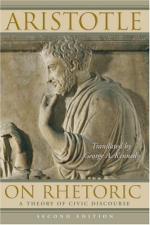
|
| Name: _________________________ | Period: ___________________ |
This test consists of 5 multiple choice questions, 5 short answer questions, and 10 short essay questions.
Multiple Choice Questions
1. How did Aristotle think a political orator should convince an audience of their plan?
(a) By showing that it was just as good as all other options.
(b) By showing that it was better than most other options.
(c) By showing that it was better than all other options.
(d) By showing that it was just as good as most other options.
2. How many different subjects of political oratory did Aristotle discuss in Book I, Chapter 4?
(a) Four.
(b) Three.
(c) Two.
(d) Five.
3. What did Aristotle think anger was always directed towards?
(a) A specific person or group, or a specific circumstance.
(b) A specific circumstance.
(c) A specific person.
(d) A group of people.
4. Which type of disgraces made shame especially significant in Aristotle's opinion?
(a) Moral.
(b) Individual.
(c) Collective.
(d) Financial.
5. What definition did Aristotle provide for rhetoric in Book I, Chapter 2?
(a) The faculty of observe in only certain cases the means of persuasion.
(b) The faculty of observe in any given case the means of conversation.
(c) The faculty of observe in any given case the means of persuasion.
(d) The faculty of observe in only certain cases the means of conversation.
Short Answer Questions
1. Which of the following would be considered an ideal target for a crime?
2. Which one of the following was not included by Aristotle as a cause for the feeling of calmness?
3. What was included in the special laws referenced by Aristotle?
4. What was another word used for "legal" in Aristotle's discussion of legal rhetoric?
5. Which one of the following was an example of national defense provided in Book I, Chapter 4?
Short Essay Questions
1. Besides war and peace and national defense, what other subjects of political oratory did Aristotle include in Book 1, Chapter 4?
2. Why would rhetoric be used to help define individual beliefs?
3. What were the two types of laws explained in Book I, Chapter 10?
4. How were friendship and enmity described by Aristotle?
5. What definition did Aristotle give for 'rhetoric' at the beginning of the book?
6. Why was happiness thought to be a key component in political rhetoric?
7. Which tactics did Aristotle indicate a epideictic rhetorician could use?
8. What benefits might ancient witnesses and recent witnesses have for legal rhetoric?
9. Why did Aristotle think that kindness received no compensation?
10. How were the three main areas of rhetoric introduced by Aristotle?
|
This section contains 898 words (approx. 3 pages at 300 words per page) |

|




